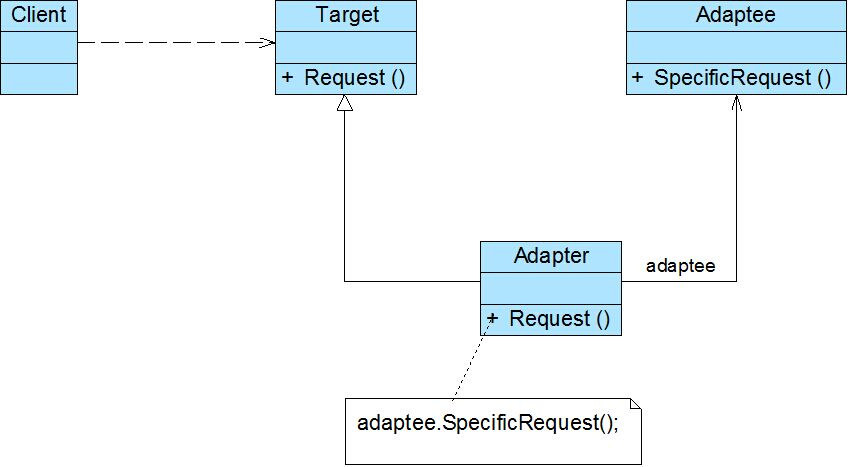设计模式第一弹—适配器模式
2018-09-30 00:27
253 查看
1、场景
2、类别
2.1类代理


// 已存在的、具有特殊功能、但不符合我们既有的标准接口的类
class Adaptee {
public void specificRequest() {
System.out.println("被适配类具有 特殊功能...");
}
}
// 目标接口,或称为标准接口
interface Target {
public void request();
}
// 具体目标类,只提供普通功能
class ConcreteTarget implements Target {
public void request() {
System.out.println("普通类 具有 普通功能...");
}
}
// 适配器类,继承了被适配类,同时实现标准接口
class Adapter extends Adaptee implements Target{
public void request() {
super.specificRequest();
}
}
// 测试类
public class Client {
public static void main(String[] args) {
// 使用普通功能类
Target concreteTarget = new ConcreteTarget();
concreteTarget.request();
// 使用特殊功能类,即适配类
Target adapter = new Adapter();
adapter.request();
}
}
2.2对象代理


// 适配器类,直接关联被适配类,同时实现标准接口
class Adapter implements Target{
// 直接关联被适配类
private Adaptee adaptee;
// 可以通过构造函数传入具体需要适配的被适配类对象
public Adapter (Adaptee adaptee) {
this.adaptee = adaptee;
}
public void request() {
// 这里是使用委托的方式完成特殊功能
this.adaptee.specificRequest();
}
}
// 测试类
public class Client {
public static void main(String[] args) {
// 使用普通功能类
Target concreteTarget = new ConcreteTarget();
concreteTarget.request();
// 使用特殊功能类,即适配类,
// 需要先创建一个被适配类的对象作为参数
Target adapter = new Adapter(new Adaptee());
adapter.request();
}
}
相关文章推荐
- iOS设计模式---适配器模式
- 设计模式系列七 适配器模式介绍
- 设计模式六 之 适配器模式(Adapter Pattern)
- IOS设计模式之三(适配器模式,观察者模式)
- 设计模式之适配器模式
- 设计模式之适配器模式
- 【四】设计模式——适配器模式(Adapter Pattern)
- java设计模式【全】-适配器模式
- java设计模式之适配器模式
- Java设计模式 -- 适配器模式
- Java设计模式之适配器模式(Adapter)在Android中的应用
- 设计模式之适配器模式
- 设计模式之禅之设计模式-适配器模式
- 设计模式学习笔记十四:适配器模式、桥接模式与外观模式
- 设计模式学习笔记——适配器模式
- Java设计模式学习05——适配器模式
- 设计模式学习--------5.适配器模式学习
- 设计模式之——适配器模式详解
- 设计模式—适配器模式
- 设计模式学习笔记-适配器模式
